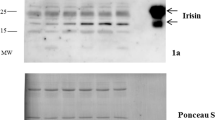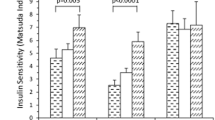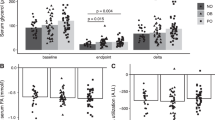Abstract
OBJECTIVE: Obesity results in insulin resistance. Bariatric surgery for obese individuals induces weight loss, improves insulin sensitivity, and lowers insulin levels. We investigated the mechanisms of this improvement.
DESIGN: Insulin receptor (IR) content, IR signaling, and adiponectin levels were measured in nine morbidly obese subjects before and after bariatric surgery.
SUBJECTS: Seven female and two male, average age 44±2y, BMI >40 kg/m2 and/or at least 100 lbs over ideal body weight, undergoing elective bariatric surgery.
MEASUREMENTS: Before surgery BMI, fasting plasma glucose, adiponectin, and insulin levels were measured. A fasting muscle biopsy was obtained from the vastus lateralis for IR concentration and autophosphorylation activity measurements. These procedures were repeated 1 y after surgery.
RESULTS: At 1 y after surgery, the subjects had lost an average of 48.3±5.6 kg (P<0.001), insulin sensitivity had significantly increased as determined by the minimal model (SI 0.72±0.18 vs 3.86±1.43, P<0.05), and IR content had increased two-fold in muscle (2.1±0.4 vs 4.3±0.7 ng/mg protein, P<0.01). The increase in IR content was related to fasting insulin levels. In the subjects with the lowest IR function, there was also an increase in IR function. Plasma adiponectin increased by 40% following weight loss (7.4±1.6 pre vs 10.3±1.3 mg/ml post, P<0.05). There was no significant change in muscle content of the IR inhibitor, PC-1.
CONCLUSION: Increased IR content, most likely regulated by insulin levels, may be one contributor to the increased insulin sensitivity that occurs when morbidly obese patients undergo bariatric surgery.
This is a preview of subscription content, access via your institution
Access options
Subscribe to this journal
Receive 12 print issues and online access
$259.00 per year
only $21.58 per issue
Buy this article
- Purchase on Springer Link
- Instant access to full article PDF
Prices may be subject to local taxes which are calculated during checkout





Similar content being viewed by others
References
Czech MP . The nature and regulation of the insulin receptor: structure and function. Annu Rev Physiol 1985; 47: 357–381.
Goldfine ID . The insulin receptor: molecular biology and transmembrane signaling. Endocr Rev 1987; 8: 235–255.
Wilden PA, Kahn CR, Siddle K, White MF . Insulin receptor kinase domain autophosphorylation regulates receptor enzymatic function. J Biol Chem 1992; 267: 16660–16668.
Virkamaki A, Ueki K, Kahn CR . Protein–protein interaction in insulin signaling and the molecular mechanisms of insulin resistance. J Clin Invest 1999; 103: 931–943.
White MF . The IRS-signalling system: a network of docking proteins that mediate insulin action. Mol Cell Biochem 1998; 182: 3–11.
Okabayashi Y, Maddux BA, McDonald AR, Logsdon CD, Williams JA, Goldfine ID . Mechanisms of insulin-induced insulin-receptor downregulation. Decrease of receptor biosynthesis and mRNA levels. Diabetes 1989; 38: 182–187.
Sbraccia P, Wong KY, Brunetti A, Rafaeloff R, Trischitta V, Hawley DM, Goldfine ID . Insulin down-regulates insulin receptor number and up-regulates insulin receptor affinity in cells expressing a tyrosine kinase-defective insulin receptor. J Biol Chem 1990; 265: 4902–4907.
Arner P, Pollare T, Lithell H, Livingston JN . Defective insulin receptor tyrosine kinase in human skeletal muscle in obesity and type 2 (non-insulin-dependent) diabetes mellitus. Diabetologia 1987; 30: 437–440.
Caro JF, Sinha MK, Raju SM, Ittoop O, Pories WJ, Flickinger EG, Meelheim D, Dohm GL . Insulin receptor kinase in human skeletal muscle from obese subjects with and without noninsulin dependent diabetes. J Clin Invest 1987; 79: 1330–1337.
Goodyear LJ, Giorgino F, Sherman LA, Carey J, Smith RJ, Dohm GL . Insulin receptor phosphorylation, insulin receptor substrate-1 phosphorylation, and phosphatidylinositol 3-kinase activity are decreased in intact skeletal muscle strips from obese subjects. J Clin Invest 1995; 95: 2195–2204.
Youngren JF, Goldfine ID, Pratley RE . Decreased muscle insulin receptor kinase correlates with insulin resistance in normoglycemic Pima Indians. Am J Physiol 1997; 273: E276–E283.
Colman E, Katzel LI, Rogus E, Coon P, Muller D, Goldberg AP . Weight loss reduces abdominal fat and improves insulin action in middle-aged and older men with impaired glucose tolerance. Metabolism 1995; 44: 1502–1508.
Goodpaster BH, Kelley DE, Wing RR, Meier A, Thaete FL . Effects of weight loss on regional fat distribution and insulin sensitivity in obesity. Diabetes 1999; 48: 839–847.
Niskanen L, Uusitupa M, Sarlund H, Siitonen O, Paljarvi L, Laakso M . The effects of weight loss on insulin sensitivity, skeletal muscle composition and capillary density in obese non-diabetic subjects. Int J Obes Relat Metab Disord 1996; 20: 154–160.
Friedman JE, Dohm GL, Leggett-Frazier N, Elton CW, Tapscott EB, Pories WP, Caro JF . Restoration of insulin responsiveness in skeletal muscle of morbidly obese patients after weight loss. Effect on muscle glucose transport and glucose transporter GLUT4. J Clin Invest 1992; 89: 701–705.
Pories WJ, MacDonald Jr KG, Morgan EJ, Sinha MK, Dohm GL, Swanson MS, Barakat HA, Khazanie PG, Leggett-Frazier N, Long SD . Surgical treatment of obesity and its effect on diabetes: 10-y follow-up. Am J Clin Nutr 1992; 55 Suppl: 582S–585S.
Havel PJ . Control of energy homeostasis and insulin action by adipocyte hormones: leptin, acylation stimulating protein, and adiponectin. Curr Opin Lipidol 2002; 13: 51–59.
Pories WJ, Swanson MS, Macdonald KG, Long SB, Morris PG, Brown BM, Barakat HA, deRamon RA, Israel G, Dolezal JM . Who would have thought it? An operation proves to be the most effective therapy for adult-onset diabetes mellitus. Ann Surg 1995; 222: 339–350.
Livingston EH . Obesity and its surgical management. Am J Surg 2002; 184: 103–113.
Finegood DT, Hramiak IM, Dupre J . A modified protocol for estimation of insulin sensitivity with the minimal model of glucose kinetics in patients with insulin-dependent diabetes. J Clin Endocrinol Metab 1990; 70: 1538–1549.
Arita Y, Kihara S, Ouchi N, Takahashi M, Maeda K, Miyagawa J, Hotta K, Shimomura I, Nakamura T, Miyaoka K, Kuriyama H, Nishida M, Yamashita S, Okubo K, Matsubara K, Muraguchi M, Ohmoto Y, Funahashi T, Matsuzawa Y . Paradoxical decrease of an adipose-specific protein, adiponectin, in obesity. Biochem Biophys Res Commun 1999; 257: 79–83.
Bradford MM . A rapid and sensitive method for the quantitation of microgram quantities of protein utilizing the principle of protein–dye binding. Anal Biochem 1976; 72: 248–254.
Frittitta L, Youngren JF, Sbraccia P, D'Adamo M, Buongiorno A, Vigneri R, Goldfine ID, Trischitta V . Increased adipose tissue PC-1 protein content, but not tumour necrosis factor-alpha gene expression, is associated with a reduction of both whole body insulin sensitivity and insulin receptor tyrosine-kinase activity. Diabetologia 1997; 40: 282–289.
Maddux BA, Sbraccia P, Kumakura S, Sasson S, Youngren J, Fisher A, Spencer S, Grupe A, Henzel W, Stewart TA . Membrane glycoprotein PC-1 and insulin resistance in non-insulin-dependent diabetes mellitus. Nature 1995; 373: 448–451.
Garvey WT, Olefsky JM, Marshall S . Insulin induces progressive insulin resistance in cultured rat adipocytes. Sequential effects at receptor and multiple postreceptor sites. Diabetes 1986; 35: 258–267.
Gavin III JR, Roth J, Neville Jr DM, de Meyts P, Buell DN . Insulin-dependent regulation of insulin receptor concentrations: a direct demonstration in cell culture. Proc Natl Acad Sci USA 1974; 71: 84–88.
Wigand JP, Blackard WG . Downregulation of insulin receptors in obese man. Diabetes 1979; 28: 287–291.
Federici M, Lauro D, D'Adamo M, Giovannone B, Porzio O, Mellozzi M, Tamburrano G, Sbraccia P, Sesti G . Expression of insulin/IGF-I hybrid receptors is increased in skeletal muscle of patients with chronic primary hyperinsulinemia. Diabetes 1998; 47: 87–92.
Federici M, Porzio O, Lauro D, Borboni P, Giovannone B, Zucaro L, Hribal ML, Sesti G . Increased abundance of insulin/insulin-like growth factor-I hybrid receptors in skeletal muscle of obese subjects is correlated with in vivo insulin sensitivity. J Clin Endocrinol Metab 1998; 83: 2911–2915.
Ducluzeau PH, Perretti N, Laville M, Andreelli F, Vega N, Riou JP, Vidal H . Regulation by insulin of gene expression in human skeletal muscle and adipose tissue. Evidence for specific defects in type 2 diabetes. Diabetes 2001; 50: 1134–1142.
Youngren JF, Keen S, Kulp JL, Tanner CJ, Houmard JA, Goldfine ID . Enhanced muscle insulin receptor autophosphorylation with short-term aerobic exercise training. Am J Physiol Endocrinol Metab 2001; 280: E528–E533.
Youngren JF, Paik J, Barnard RJ . Impaired insulin-receptor autophosphorylation is an early defect in fat-fed, insulin-resistant rats. J Appl Physiol 2001; 91: 2240–2247.
Boden G . Interaction between free fatty acids and glucose metabolism. Curr Opin Clin Nutr Metab Care 2002; 5: 545–549.
Kelley DE, Goodpaster BH, Storlien L . Muscle triglyceride and insulin resistance. Annu Rev Nutr 2002; 22: 325–346.
McGarry JD . Banting lecture 2001: dysregulation of fatty acid metabolism in the etiology of type 2 diabetes. Diabetes 2002; 51: 7–18.
Ravussin E, Smith SR . Increased fat intake, impaired fat oxidation, and failure of fat cell proliferation result in ectopic fat storage, insulin resistance, and type 2 diabetes mellitus. Ann N Y Acad Sci 2002; 967: 363–378.
Cnop M, Havel PJ, Utzschneider KM, Carr DB, Gingerich RL, Sinha MK, Boyko EJ, Retzlaff BM, Knopp RH, Brunzell JD, Kahn SE . Relationship of adiponectin to body fat distribution, insulin sensitivity and plasma lipoproteins: evidence for independent roles of age and gender. Diabetologia 2003; 46: 459–469.
Stefan N, Vozarova B, Funahashi T, Matsuzawa Y, Weyer C, Lindsay RS, Youngren JF, Havel PJ, Pratley RE, Bogardus C, Tataranni PA . Plasma adiponectin concentration is associated with skeletal muscle insulin receptor tyrosine phosphorylation, and low plasma concentration precedes a decrease in whole-body insulin sensitivity in humans. Diabetes 2002; 51: 1884–1888.
Yamauchi T, Kamon J, Waki H, Terauchi Y, Kubota N, Hara K, Mori Y, Ide T, Murakami K, Tsuboyama-Kasaoka N, Ezaki O, Akanuma Y, Gavrilova O, Vinson C, Reitman ML, Kagechika H, Shudo K, Yoda M, Nakano Y, Tobe K, Nagai R, Kimura S, Tomita M, Froguel P, Kadowaki T . The fat-derived hormone adiponectin reverses insulin resistance associated with both lipoatrophy and obesity. Nat Med 2001; 7: 941–946.
Tomas E, Tsao TS, Saha AK, Murrey HE, Zhang CC, Itani SI, Lodish HF, Ruderman NB . Enhanced muscle fat oxidation and glucose transport by ACRP30 globular domain: acetyl-CoA carboxylase inhibition and AMP-activated protein kinase activation. Proc Natl Acad Sci USA 2002; 99: 16309–16313.
Faraj M, Havel PJ, Phelis S, Blank D, Sniderman AD, Cianflone K . Plasma acylation stimulating protein, adiponectin, leptin and ghrelin before and following weight loss induced by gastic bypass surgery in morbidly obese subjects. J Clin Endocrinol Metab 2003; 88: 1594–1602.
Acknowledgements
This work was supported by grants from the American Diabetes Association and the American Physiological Society. We would also like to express our gratitude for the technical assistance of Kimber Stanhope in conducting the adiponectin assay.
Author information
Authors and Affiliations
Corresponding author
Rights and permissions
About this article
Cite this article
Pender, C., Goldfine, I., Tanner, C. et al. Muscle insulin receptor concentrations in obese patients post bariatric surgery: relationship to hyperinsulinemia. Int J Obes 28, 363–369 (2004). https://doi.org/10.1038/sj.ijo.0802565
Published:
Issue Date:
DOI: https://doi.org/10.1038/sj.ijo.0802565
Keywords
This article is cited by
-
Liver ENPP1 protein increases with remission of type 2 diabetes after gastric bypass surgery
BMC Gastroenterology (2014)
-
HMGA1 is a novel downstream nuclear target of the insulin receptor signaling pathway
Scientific Reports (2012)
-
Mechanisms of improved glycaemic control after Roux-en-Y gastric bypass
Diabetologia (2012)
-
Myocardial Insulin Signaling and Glucose Transport Are Up-regulated in Goto–Kakizaki Type 2 Diabetic Rats After Ileal Transposition
Obesity Surgery (2012)
-
Bypassing the Duodenum Does Not Improve Insulin Resistance Associated With Diet‐Induced Obesity in Rodents
Obesity (2011)



